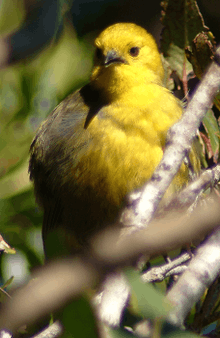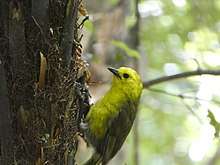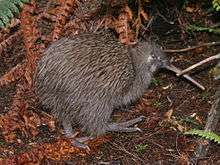Yellowhead (bird)
The yellowhead or mohua (Māori: mōhua; Mohoua ochrocephala); also known as bush canary[2]) is a small insectivorous, passerine bird endemic to the South Island of New Zealand. Recent classification places this species and its close relative, the Whitehead, in the family Mohouidae.
| Yellowhead | |
|---|---|
 | |
| Yellowhead or mohua | |
| Scientific classification | |
| Kingdom: | Animalia |
| Phylum: | Chordata |
| Class: | Aves |
| Order: | Passeriformes |
| Family: | Mohouidae |
| Genus: | Mohoua |
| Species: | M. ochrocephala |
| Binomial name | |
| Mohoua ochrocephala (Gmelin, 1789) | |
 | |
The yellowhead and the whitehead have allopatric distributions as, conversely, the latter is found only in the North Island and several small islands surrounding it. Although abundant in the 19th century, particularly in beech forests from Nelson and the Marlborough Sounds to Southland and Stewart Island/Rakiura, they declined dramatically in the early 20th century due to the introduction of black rats and mustelids. Today they have vanished from nearly 75% of their former range. A quarter of the mohua population now lives in the beech forests of the Catlins area.
Conservation
In New Zealand, mohua have the status of a protected threatened endemic species. Conservation efforts are being made to ensure its survival and mohua populations have been established on several predator-free offshore islands, such as Breaksea Island in Fiordland and Ulva Island.

Pest control efforts by the Department of Conservation have managed to stabilise some mainland mohua populations. For example, where biodegradable 1080 poison was used to control rats in the Dart valley, there was a more than 80% survival rate, compared with just 10% in untreated areas.[3] The population of mohua in the Landsborough valley has increased four-fold since 1998, thanks to an intensive programme of pest control, including aerial 1080. The population is now strong enough for birds to be transferred out to establish a new population on Resolution Island. Similar aerial 1080 operations in the Catlins[4] and the Hurunui,[5] Hawdon and Eglinton valleys[6] have had equally encouraging results. DOC and TBfree New Zealand accounted in March 2014 a significant repopulation in the Catlins of other avian species, including bellbird and tomtit due to the reduction in predators.[7]
Popular culture
The yellowhead appears on the reverse side of the New Zealand $100 note.
References
- BirdLife International (2012). "Mohoua ochrocephala". IUCN Red List of Threatened Species. 2012. Retrieved 26 November 2013.CS1 maint: ref=harv (link)
- "Yellowhead | New Zealand Birds Online". nzbirdsonline.org.nz. Retrieved 15 June 2019.
- Making mohua safe at Lake Wakatipu
- TVNZ: 1080 poison pays off for endangered NZ bird
- Department of Conservation
- 1080: The Facts: 1080 helping mohua
- Department of Conservation http://doc.govt.nz/about-doc/news/media-releases/2014/catlins-mohua-increase-after-pest-control/ 7 March 2014
Literature
- Heather, Barrie D; Robertson, Hugh A & Onley, Derek (2000). The field guide to the birds of New Zealand. Viking: Printing Press. ISBN 0-670-89370-6.
External links
- Mōhua Charitable Trust
- "Department of Conservation: Mohua (Yellowhead)". Mohua (Yellowhead). Retrieved 18 May 2020.

